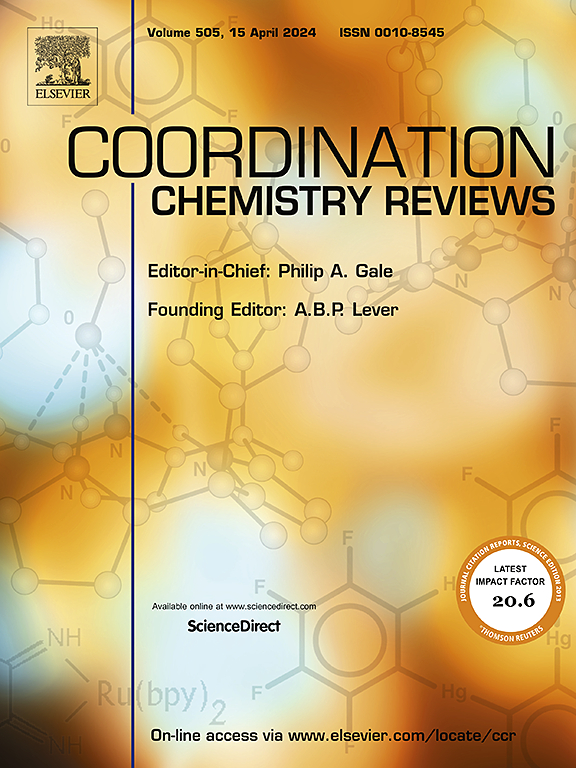First-principles calculation studies of metal-organic frameworks and their derivatives for electrochemical energy conversion and storage
IF 20.3
1区 化学
Q1 CHEMISTRY, INORGANIC & NUCLEAR
引用次数: 0
Abstract
Researchers are increasingly focusing on seeking for advanced electrode materials for high-performance secondary batteries and electrocatalysis. One effective method involves the density functional theory-based first-principles calculations, which is used to design and fabricate novel electrode materials. This computational approach predicts electronic structures, chemical bonding, and electrochemical properties at the atomic scale to evaluate their energy storage and conversion performance. Among all energy materials, metal-organic frameworks (MOFs) and their derivatives exhibit significant advantages over traditional electrode materials. These advantages include cost-effective synthesis, high specific surface area, tunable porosity, customizable functionality, electrochemical stability, and their potential to form elaborate heterostructures. First-principles calculations effectively predict the electronic structures of MOF-based materials and the mechanisms of energy conversion and storage. This review pays close attention to the adsorption and diffusivity of metal ions within the porous structures of MOFs and their derivatives, as well as their electrocatalytic behavior and structural stability under varying electrochemical conditions. The discussion begins with the significance of first-principles computation methods in electrochemistry, followed by their application in the study of the electrochemical behaviors of MOFs and derivatives in lithium-ion, sodium-ion, potassium-ion, and lithium‑sulfur batteries, supercapacitors, electrocatalysis, and other battery systems. Finally, we provide mechanistic insights and demonstrate the predictive potential of first-principles calculations for the proper development and optimization of MOF-based materials for diverse energy applications.

电化学能量转换与存储用金属-有机骨架及其衍生物的第一性原理计算研究
研究人员越来越关注高性能二次电池和电催化的先进电极材料的研究。一种有效的方法是基于密度泛函理论的第一性原理计算,用于设计和制造新型电极材料。这种计算方法在原子尺度上预测电子结构、化学键和电化学性能,以评估它们的能量存储和转换性能。在所有能源材料中,金属有机框架(mof)及其衍生物比传统的电极材料具有显著的优势。这些优势包括合成成本低、比表面积高、孔隙度可调、可定制功能、电化学稳定性以及形成复杂异质结构的潜力。第一性原理计算有效地预测了mof基材料的电子结构以及能量转换和储存机制。本文重点研究了金属离子在mof及其衍生物的多孔结构中的吸附和扩散特性,以及它们在不同电化学条件下的电催化行为和结构稳定性。首先讨论第一性原理计算方法在电化学中的意义,然后讨论第一性原理计算方法在研究mof及其衍生物在锂离子、钠离子、钾离子、锂硫电池、超级电容器、电催化和其他电池系统中的电化学行为中的应用。最后,我们提供了机制的见解,并展示了第一性原理计算的预测潜力,为不同能源应用的mof基材料的适当开发和优化。
本文章由计算机程序翻译,如有差异,请以英文原文为准。
求助全文
约1分钟内获得全文
求助全文
来源期刊

Coordination Chemistry Reviews
化学-无机化学与核化学
CiteScore
34.30
自引率
5.30%
发文量
457
审稿时长
54 days
期刊介绍:
Coordination Chemistry Reviews offers rapid publication of review articles on current and significant topics in coordination chemistry, encompassing organometallic, supramolecular, theoretical, and bioinorganic chemistry. It also covers catalysis, materials chemistry, and metal-organic frameworks from a coordination chemistry perspective. Reviews summarize recent developments or discuss specific techniques, welcoming contributions from both established and emerging researchers.
The journal releases special issues on timely subjects, including those featuring contributions from specific regions or conferences. Occasional full-length book articles are also featured. Additionally, special volumes cover annual reviews of main group chemistry, transition metal group chemistry, and organometallic chemistry. These comprehensive reviews are vital resources for those engaged in coordination chemistry, further establishing Coordination Chemistry Reviews as a hub for insightful surveys in inorganic and physical inorganic chemistry.
 求助内容:
求助内容: 应助结果提醒方式:
应助结果提醒方式:


